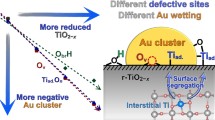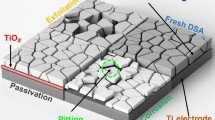Abstract
The oxidation of chalcopyrite, CuFeS2, is still not well understood and relevant in the context of the hydrometallurgical extraction of copper. Herein, we used DFT calculations within the periodic boundary conditions formalism to study the adsorption of O2 and [Fe(H2O)2(OH)3] molecules on the (001) and (112) surfaces of CuFeS2. The O2 molecule adsorbs strongly by a dissociative pathway at sulfur atoms on the (001) surface with an adsorption energy of − 76.5 kcal mol−1. The surface is chemically modified forming SO2 groups, in which the S–O bond length is calculated to be 1.47 and 1.54 Å. PDOS and Löwdin charges analyses indicate the oxidation of the sulfur atoms on the surface. We tested different adsorption modes of [Fe(H2O)2(OH)3], and a bidantade coordination with the Oads–Fesur and Feads–Ssur bond lengths of 2.02 and 2.47 Å is the most favorable with an adsorption energy of − 18.8 kcal mol−1 on the (001) surface. Adsorptions of each species are also observed on the (112) surface, but they are weaker than those observed on the (001) surface.








Similar content being viewed by others
Data availability
Additional figures and all optimized coordinates are available in the Supplementary Information and further information can be requested directly from the corresponding author.
References
Córdoba EM, Muñoz JA, Blázquez ML et al (2008) Leaching of chalcopyrite with ferric ion Part I: General aspects. Hydrometallurgy 93:81–87. https://doi.org/10.1016/j.hydromet.2008.04.015
Davenport WG, King M, Schlesinger M, Biswas AK (2002) Extractive metallurgy of copper, 4th edn. Pergamon, Oxford
Dutrizac JE (1989) Elemental sulphur formation during the ferric sulphate leaching of chalcopyrite. Can Metall Q 28:337–344. https://doi.org/10.1179/cmq.1989.28.4.337
Schlesinger ME, King MJ, Sole KC, Davenport WG (2011) Chapter 15 - hydrometallurgical copper extraction: introduction and leaching. In: Schlesinger ME, King MJ, Sole KC, Davenport WG (eds) Extractive Metallurgy of Copper, 5th edn. Elsevier, Oxford, pp 281–322
Vizsolyi A, Veltman H, Warren IH, Mackiw VN (1967) Copper and elemental sulphur from chalcopyrite by pressure leaching. JOM 19:52–59. https://doi.org/10.1007/BF03378656
Yu PH, Hansen CK, Wadsworth ME (1973) A kinetic study of the leaching of chalcopyrite at elevated temperatures. Metall Trans 4:2137–2144. https://doi.org/10.1007/BF02643279
Munoz PB, Miller JD, Wadsworth ME (1979) Reaction mechanism for the acid ferric sulfate leaching of chalcopyrite. Metall Trans B 10:149–158. https://doi.org/10.1007/BF02652458
Hiroyoshi N, Hirota M, Hirajima T, Tsunekawa M (1997) A case of ferrous sulfate addition enhancing chalcopyrite leaching. Hydrometallurgy 47:37–45. https://doi.org/10.1016/S0304-386X(97)00032-7
Venkatachalam S (1991) Treatment of chalcopyrite concentrates by hydrometallurgical techniques. Miner Eng 4:1115–1126. https://doi.org/10.1016/0892-6875(91)90087-C
Klauber C (2008) A critical review of the surface chemistry of acidic ferric sulphate dissolution of chalcopyrite with regards to hindered dissolution. Int J Miner Process 86:1–17. https://doi.org/10.1016/j.minpro.2007.09.003
Acres RG, Harmer SL, Beattie DA (2010) Synchrotron XPS studies of solution exposed chalcopyrite, bornite, and heterogeneous chalcopyrite with bornite. Int J Miner Process 94:43–51. https://doi.org/10.1016/j.minpro.2009.11.006
Majuste D, Ciminelli VST, Eng PJ, Osseo-Asare K (2013) Applications of in situ synchrotron XRD in hydrometallurgy: literature review and investigation of chalcopyrite dissolution. Hydrometallurgy 131–132:54–66. https://doi.org/10.1016/j.hydromet.2012.10.001
Xiong X, Hua X, Zheng Y et al (2018) Oxidation mechanism of chalcopyrite revealed by X-ray photoelectron spectroscopy and first principles studies. Appl Surf Sci 427:233–241. https://doi.org/10.1016/j.apsusc.2017.08.047
Parker GK, Woods R, Hope GA (2008) Raman investigation of chalcopyrite oxidation. Colloids Surf A Physicochem Eng Asp 318:160–168. https://doi.org/10.1016/j.colsurfa.2007.12.030
Gomes BLF de M, Bertoli AC, Duarte HA (2022) Growing mechanism of polysulfides and elemental sulfur formation: implications to hindered chalcopyrite dissolution. J Phys Chem A 126:1660–1665. https://doi.org/10.1021/acs.jpca.1c10555
Von Oertzen GU, Harmer SL, Skinner WM (2006) XPS and ab initio calculation of surface states of sulfide minerals: pyrite, chalcopyrite and molybdenite. Mol Simul 32:1207–1212. https://doi.org/10.1080/08927020601081616
Wei Z, Li Y, Gao H et al (2019) New insights into the surface relaxation and oxidation of chalcopyrite exposed to O2 and H2O: a first-principles DFT study. Appl Surf Sci 492:89–98. https://doi.org/10.1016/j.apsusc.2019.06.191
de Lima GF, de Oliveira C, de Abreu HA, Duarte HA (2011) Water adsorption on the reconstructed (001) chalcopyrite surfaces. J Phys Chem C 115:10709–10717. https://doi.org/10.1021/jp201106e
de Lima GF, Duarte HA, Pettersson LGM (2018) X-ray absorption near-edge spectroscopy calculations on pristine and modified chalcopyrite surfaces. J Phys Chem C 122:20200–20209. https://doi.org/10.1021/acs.jpcc.8b02191
Hall SR, Stewart JM (1973) The crystal structure refinement of chalcopyrite, CuFeS2. Acta Crystallogr Sect B 29:579–585. https://doi.org/10.1107/S0567740873002943
McMillan RS, MacKinnon DJ, Dutrizac JE (1982) Anodic dissolution of n-type and p-type chalcopyrite. J Appl Electrochem 12:743–757. https://doi.org/10.1007/BF00617495
Li Y, Kawashima N, Li J et al (2013) A review of the structure, and fundamental mechanisms and kinetics of the leaching of chalcopyrite. Adv Colloid Interface Sci 197–198:1–32. https://doi.org/10.1016/j.cis.2013.03.004
Pearce CI, Pattrick RAD, Vaughan DJ et al (2006) Copper oxidation state in chalcopyrite: Mixed Cu d9 and d10 characteristics. Geochim Cosmochim Acta 70:4635–4642. https://doi.org/10.1016/j.gca.2006.05.017
Mikhlin Y, Nasluzov V, Romanchenko A et al (2017) Layered structure of the near-surface region of oxidized chalcopyrite (CuFeS2): hard X-ray photoelectron spectroscopy, X-ray absorption spectroscopy and DFT+U studies. Phys Chem Chem Phys 19:2749–2759. https://doi.org/10.1039/C6CP07598C
de Oliveira C, Duarte HA (2010) Disulphide and metal sulphide formation on the reconstructed (001) surface of chalcopyrite: A DFT study. Appl Surf Sci 257:1319–1324. https://doi.org/10.1016/j.apsusc.2010.08.059
Donnay G, Corliss LM, Donnay JDH et al (1958) Symmetry of magnetic structures: magnetic structure of chalcopyrite. Phys Rev 112:1917–1923. https://doi.org/10.1103/PhysRev.112.1917
de Oliveira C, de Lima GF, de Abreu HA, Duarte HA (2012) Reconstruction of the chalcopyrite surfACES—a DFT study. J Phys Chem C 116:6357–6366. https://doi.org/10.1021/jp300713z
de Lima GF, de Oliveira C, de Abreu HA, Duarte HA (2012) Sulfuric and hydrochloric acid adsorption on the reconstructed sulfur terminated (001) chalcopyrite surface. Int J Quantum Chem 112:3216–3222. https://doi.org/10.1002/qua.24145
Nourmohamadi H, Esrafili MD, Aghazadeh V (2019) Interaction of ferric ion with (001)-S and (001)-M surfaces of chalcopyrite (M = Fe and Cu): electrochemical insights from DFT calculations. Appl Surf Sci 495:30–33. https://doi.org/10.1016/j.apsusc.2019.07.271
Nourmohamadi H, Esrafili MD, Aghazadeh V (2021) DFT study of ferric ion interaction with passive layer on chalcopyrite surface: elemental sulfur, defective sulfur and replacement of M2+(M=Cu and Fe) ions. Comput Condens Matter 26:e00536. https://doi.org/10.1016/j.cocom.2021.e00536
de Abreu HA, Guimarães L, Duarte HA (2006) Density-functional theory study of iron(III) hydrolysis in aqueous solution. J Phys Chem A 110:7713–7718. https://doi.org/10.1021/jp060714h
Guimarães L, de Abreu HA, Duarte HA (2007) Fe(II) hydrolysis in aqueous solution: a DFT study. Chem Phys 333:10–17. https://doi.org/10.1016/j.chemphys.2006.12.023
Dos Santos EC, de Mendonça Silva JC, Duarte HA (2016) Pyrite oxidation mechanism by oxygen in aqueous medium. J Phys Chem C 120:2760–2768. https://doi.org/10.1021/acs.jpcc.5b10949
Giannozzi P, Baroni S, Bonini N et al (2009) QUANTUM ESPRESSO: a modular and open-source software project for quantum simulations of materials. J Phys Condens Matter 21:395502. https://doi.org/10.1088/0953-8984/21/39/395502
Perdew JP, Burke K, Ernzerhof M (1996) Generalized gradient approximation made simple. Phys Rev Lett 77:3865–3868. https://doi.org/10.1103/PhysRevLett.77.3865
Perdew JP, Burke K, Ernzerhof M (1997) Generalized gradient approximation made simple [Phys. Rev. Lett. 77, 3865 (1996)]. Phys Rev Lett 78:1396
Cococcioni M, de Gironcoli S (2005) Linear response approach to the calculation of the effective interaction parameters in the LDA+U method. Phys Rev B 71:35105
Cococcioni M (2012) The LDA+U approach: a simple Hubbard correction for correlated ground states. In: Pavarini E, Koch E, Anders F, Jarrell M (eds) Correlated Electrons: From Models to Materials. Forschungszentrum Jülich GmbH: Institute os Advanced Simulation
Monkhorst HJ, Pack JD (1976) Special points for Brillouin-zone integrations. Phys Rev B 13:5188–5192. https://doi.org/10.1103/PhysRevB.13.5188
Funding
This work was supported by the Brazilian agencies Conselho Nacional para o Desenvolvimento Científico e Tecnológico — CNPq (INCT-Acqua), Coordenação de Aperfeiçoamento de Pessoal de Ensino Superior — CAPES, and Fundação de Amparo à Pesquisa do Estado de Minas Gerais — FAPEMIG (APQ-00519–21 and RenovaMin, RED-00102–16).
Author information
Authors and Affiliations
Contributions
GFL and HAD coordinate the project and supervise the SFB Ph.D. SFB carried out all the calculations and drafted the first figures and tables. All the authors contributed to writing and revising the manuscript.
Corresponding author
Ethics declarations
Conflict of interest
The authors declare no competing interests.
Additional information
Publisher's Note
Springer Nature remains neutral with regard to jurisdictional claims in published maps and institutional affiliations.
This paper belongs to Topical Collection XXI - Brazilian Symposium of Theoretical Chemistry (SBQT2021).
Supplementary Information
Below is the link to the electronic supplementary material.
Rights and permissions
Springer Nature or its licensor holds exclusive rights to this article under a publishing agreement with the author(s) or other rightsholder(s); author self-archiving of the accepted manuscript version of this article is solely governed by the terms of such publishing agreement and applicable law.
About this article
Cite this article
Bazan, S.F., Duarte, H.A. & de Lima, G.F. A DFT study of the adsorption of O2 and [Fe(H2O)2(OH)3] on the (001) and (112) surfaces of chalcopyrite. J Mol Model 28, 257 (2022). https://doi.org/10.1007/s00894-022-05263-z
Received:
Accepted:
Published:
DOI: https://doi.org/10.1007/s00894-022-05263-z




